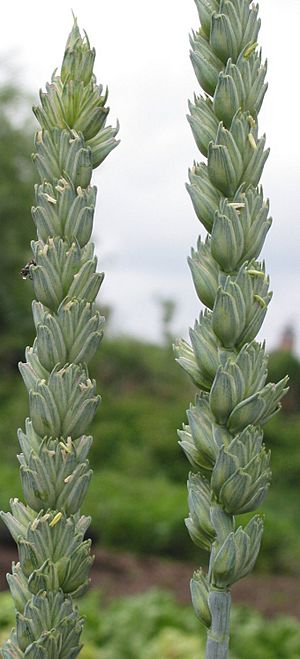Common wheat facts for kids
Quick facts for kids Common wheat |
|
|---|---|
 |
|
| Ears of common wheat | |
| Scientific classification | |
| Kingdom: | |
| (unranked): | |
| (unranked): | |
| (unranked): | |
| Order: | |
| Family: | |
| Subfamily: |
Pooideae
|
| Tribe: | |
| Genus: | |
| Binomial name | |
| Triticum aestivum |
|
Common wheat (Triticum aestivum), also known as bread wheat, is a very important type of wheat that farmers grow. It's used to make many foods we eat every day. In fact, about 95% of all the wheat grown around the world is common wheat!
| Top - 0-9 A B C D E F G H I J K L M N O P Q R S T U V W X Y Z |
How Did Bread Wheat Come to Be?
The Amazing Journey of Wheat's Genes
Bread wheat is special because it has six sets of chromosomes. Think of chromosomes as tiny instruction books inside every living thing. Bread wheat got its six sets from three different parent plants over a very long time.
First, two sets came from a plant called Triticum urartu (einkorn wheat). Then, two more sets came from a wild grass called Aegilops speltoides. When these two mixed, they created a new type of wheat called Triticum turgidum (durum wheat). This happened a very long time ago, between 580,000 and 820,000 years ago!
Later, the last two sets of chromosomes came from another wild grass called Aegilops tauschii. This final mix happened about 230,000 to 430,000 years ago, giving us the bread wheat we know today.
Why Bread Wheat is So Tough
Thanks to the genes from Aegilops tauschii, bread wheat can handle cold weather much better than most other types of wheat. This is why it can be grown in many cool places around the world.
A Quick Look at Wheat's History
Where Wheat Started Growing
Common wheat was first grown by people in Western Asia a very long time ago, when humans were just starting to farm. From there, it slowly spread to North Africa, Europe, and East Asia even before recorded history.
Wheat Comes to America
Wheat arrived in North America with Spanish explorers and missionaries in the 1500s. But it wasn't until the 1870s, when people started settling the prairies (large grasslands) in North America, that it became a major crop for export.
During the First World War, when Russia stopped exporting grain, wheat production in places like Kansas in the USA actually doubled!
Why Bread Wheat is So Popular Today
Today, bread wheat is perfect for modern baking methods. It has become much more popular than other grains like barley and rye that were once commonly used for making bread, especially in Europe.
How Scientists Make Wheat Better
Shorter Stems for Stronger Plants
Modern types of wheat have shorter stems. This is thanks to special genes called RHt dwarfing genes. These genes make the plant less sensitive to a hormone that usually makes stems grow very long.
These shorter stems are super important for farmers. If stems grew too tall, especially with lots of fertilizer, they would fall over (this is called lodging). Shorter, even stems also make it easier to harvest the wheat with modern machines. These special genes were added to wheat in the 1960s by a scientist named Norman Borlaug, using wheat from Japan called Norin 10.
Other Kinds of Common Wheat
Some types of wheat, like club wheat (Triticum compactum), are very similar to common wheat but have a much more compact or tightly packed ear. Their shorter parts mean the grains are closer together. These compact wheats are often seen as just different versions of common wheat, rather than completely separate species.
Images for kids
See also
 In Spanish: Trigo harinero para niños
In Spanish: Trigo harinero para niños


